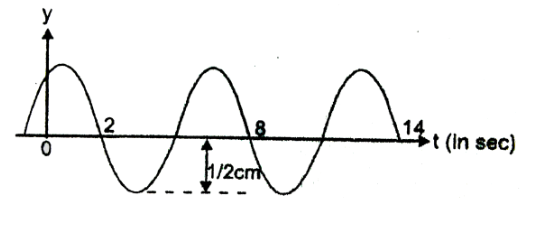Question
Question: The sketch in the figure shows the displacement time curve of a sinusoidal wave at \( x = 8m \) . Ta...
The sketch in the figure shows the displacement time curve of a sinusoidal wave at x=8m . Taking the velocity of the wave v=6ms−1 along the positive X-axis, write the equation of the wave.
(A) y=0.5sin(3πt+18πx+97π)
(B) y=0.5sin(3πt+18πx+911π)
(C) y=0.5sin(3πt−18πx+911π)
(D) y=0.5sin(3πt−18πx+97π)

Solution
Hint : Use the general equation of a sinusoidal wave and find the different parameters of the wave. The general equation of a sinusoidal wave propagating along positive X-direction is given by, y=Asin(ωt−kx+φ) . Where, A is the amplitude of the wave, ω is the angular frequency of the wave, k is the propagation constant of the wave, φ is the initial phase, x is the position of the wave and t is the time.
Complete Step By Step Answer:
We know that the equation of a sinusoidal wave propagating along positive X- direction is given by, y=Asin(ωt−kx+φ) . Where, A is the amplitude of the wave, ω is the angular frequency of the wave, k is the propagation constant of the wave, φ is the initial phase. x is the position of the wave and t is the time.
From the figure we can see that at t=2s to t=8s the wave completes one single oscillation. Now we know, the time period of a wave is the time required to complete one complete oscillation is called the time period of the wave. Hence the time period of the wave will be, T=(8−2)=6s .
Now, we know that the frequency of a wave is the total number of complete oscillation in one second.
Hence, frequency of the wave will be, f=T1=61Hz .
So, the angular frequency of the wave will be, ω=2πf .
Putting the values we get, ω=2π61=3πrad/s
Now, From the figure we can see that the amplitude of the wave is , A=0.5cm=5×10−3m .
Now we know that the propagation constant of the wave is related to the wavelength of the wave as, k=λ2π . And we know, wavelength of wave is the distance covered in one complete oscillation , λ=fv where v is the velocity of the wave.
We have given here that the velocity of the wave is, v=6ms−1 and we have found f=61Hz .
Putting the values we get, λ=616=36m .
Hence propagation constant will be, k=λ2π=362π=18πm−1
So, putting these values in the sinusoidal wave equation we get the wave equation as,
y=0.5sin(3πt−18πx+φ) [Taking displacement in cm ]
Since, there is insufficient data to find the initial phase of the wave we have to check the available options.
Now, putting, φ=911π at t=0 and x=8
we get, y=0.5sin(0−188π+911π)
Or, y=0.5sin(97π)=0.321
So, putting φ=97π at t=0 and x=8
We get, y=0.5sin(0−188π+97π)
Or, y=0.5sin(3π)=0.433
From observation of the graph we can see that the value of y t t=0 and x=8 must be near the y⩾0.4cm range. Hence, φ=97π must be the initial phase.
So, equation of the wave will be, y=0.5sin(3πt−18πx+97π)
So, Option (D) is correct.
Note :
∙ Here, if the value of the amplitude of the wave at t=0s was given we could find the initial phase of the wave directly.
∙ The equation of standing waves always has a fixed value of x . The figure of the wave given here is a standing wave since, only the variation of the displacement of the wave with time is given at x=8m , but it is not actually a standing wave since it is told that the wave is propagating along the positive X-axis.
